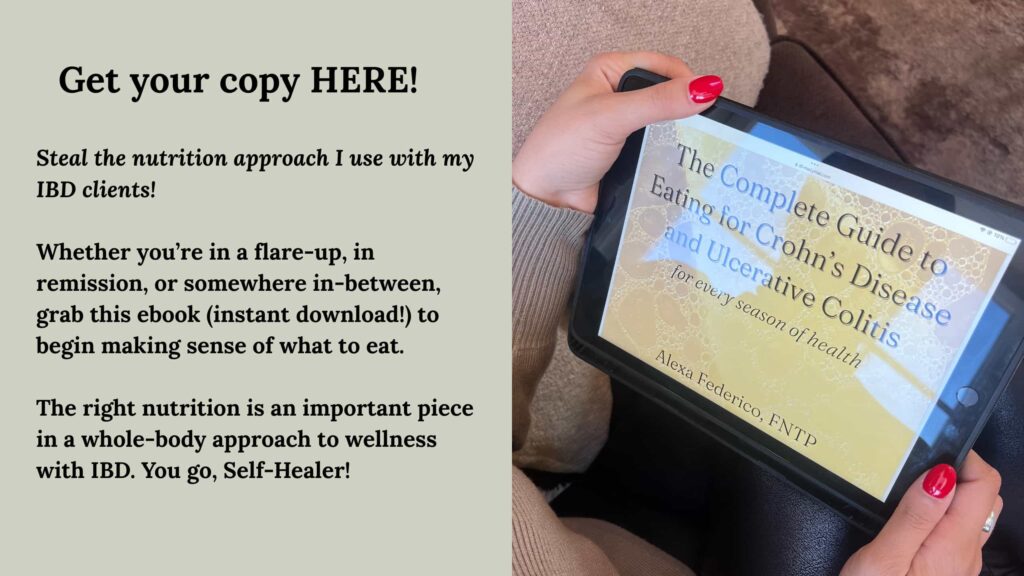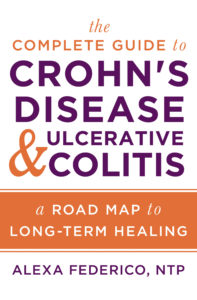So, you decided to go through an elimination diet (or healing diet, as I refer to them) to ease symptoms and kickstart healing with Crohn’s disease, ulcerative colitis, or microscopic colitis. If you are seeing improvement, that is a good sign to start adding in foods. Now, if you are using an outlined program, there may be guidelines written for that protocol to follow, but if you are doing this on your own, it can be tricky to navigate it reintroducing foods! Often, people fear their Crohn’s or UC symptoms will come back with vengeance and ruin their hard work. I completely understand that fear.
In this post I will outline some key tips for reintroducing foods that I use with my clients. If you would like a deeper dive in eating appropriately for your IBD health, my ebook, The Complete Guide to Eating for Crohn’s disease and Ulcerative Colitis Eating for Every Season of Health is the resource I designed for you!
Reintroduce one food at a time
It is of utmost importance to reintroduce just one food at a time. If you try multiple foods in a day or over the course of a couple days and do react to something, it will be difficult or impossible to know which food was the culprit. Then you are left starting from scratch, not knowing if any of those new foods actually work for you yet.
Wait at least three days before reintroducing another new food
It is so exciting when you successfully reintroduce a new food that you get eager to introduce another. Every additional food you can tolerate well means your diet just got a little more diverse and fun! Even if after a day you feel completely fine, wait out the three days at least. It is very possible, especially in IBD (I have seen this many times and personally) that one can experience a delayed reaction to something they ate. If after three full days you still feel great, you can reintroduce a new food! It also just helps your body adjust to new things. Slow and steady is always the better way to go when it comes to healing and introducing new foods, supplements, activities, etc. to the body!
Try to avoid reintroducing new foods around big or stressful life events
Sometimes you are in an unexpected situation with a lack of food options and must eat something new. It happens! But if you are in the process of a healing diet for Crohn’s or colitis, knowing that you are about to begin reintroducing foods, be intentional with timing. If you have a wedding to attend, lots of travel, a home move, a new job, hosting visiting family, etc., I recommend avoiding introductions within a week before these things. The stress from these events could exacerbate the reintroduction process and give you the idea that a food did not agree with your body when in fact, it was your stress.
If you do experience a reaction, wait to begin the process again
Wait until you reach your baseline state of health again before trying another new food. If your body is now in a reactive state from a less-than-successful food reintroduction, it’s likely the success of a new food will be very unclear! Wait it out – which might be more than the three days mentioned above – until you feel like yourself again.
Track everything
Food and symptom journals are incredibly helpful for Crohn’s disease and ulcerative colitis and they are an important piece of reintroductions! It is much easier for us to forget details of eating new foods than we may think. I recommend tracking:
- what you ate
- when you ate it (date, time of day, before/after certain activities)
- where you ate (homemade meal vs eating at restaurant)
- how your emotions were that day
- other new changes that were occurring (i.e. changes to schedule)
- bowel movements / other symptoms
Food and symptom journaling helps to connect some puzzle pieces and do some hard work for you (remembering all these details) so you don’t have to.
If you need more help with knowing what to eat, what to reintroduce, and when, grab a hold of my ebook!
I designed this ebook for people in any stage of health with their Crohn’s disease or ulcerative colitis (and microscopic colitis!) to navigate eating an appropriate diet and move through dietary reintroductions.







